Jackson County Jail and Marshal's Home (1859 Jail Museum)
Introduction
Text-to-speech Audio
Now known as the 1859 Jail Museum, the Jackson County Jail and Marshal’s Home was operational from 1859 until its official decommissioning in 1933, and during that time had a variety of uses. It was a private residence for the standing jailer and his family, held violators of Prohibition laws, and was used for Works Progress Administration projects during the Great Depression. The jail was also central to the Civil War in the Missouri-Kansas border region, during which it was used as a hospital, the U.S. Provost Marshal’s office, and held both military and civilian prisoners during the infamous Order Number 11. Some of its more famous inmates include guerrilla leader William Clarke Quantrill and outlaw Frank James. By 1958, the jail was slated for demolition, but the Jackson County Historical Society, with the help of former president Harry Truman, purchased, restored, and converted it into a museum, which has been open since the jail’s centennial year, 1959.
Images
The Jackson County Jail and Marshal's House was erected in 1859 and is now a museum operated by the Jackson County Historical Society.
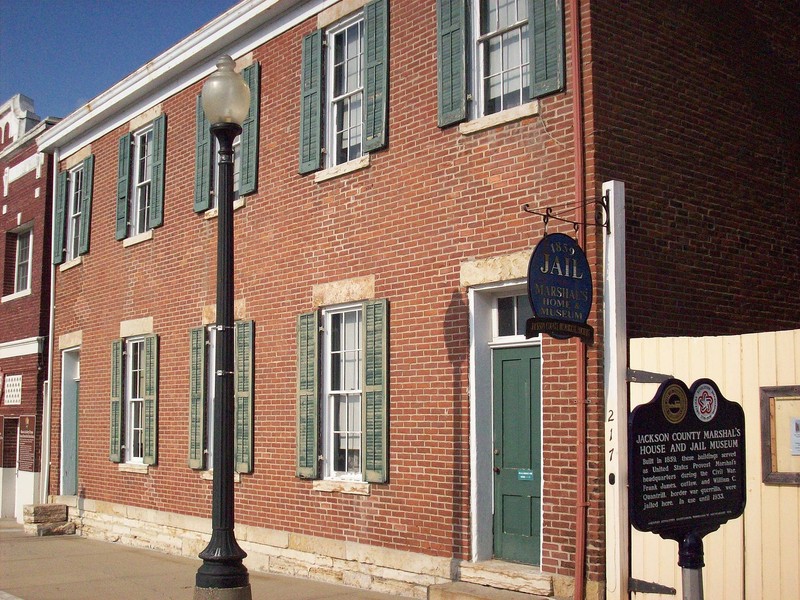
Closeup of the historical marker in front of the building.
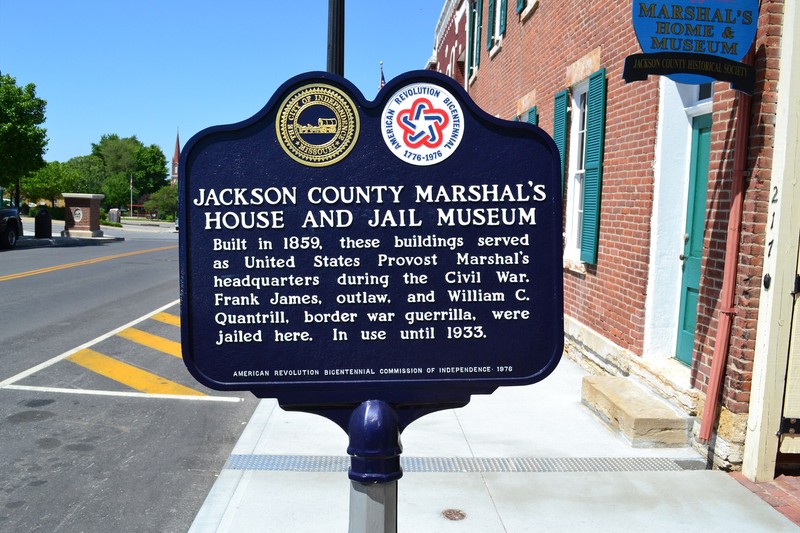
Frank James, age 23, in 1866.
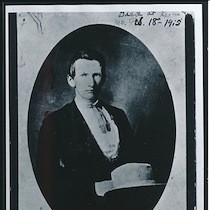
A group tours the museum during its grand opening on October 4, 1959.
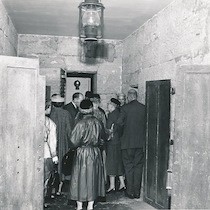
Guerrilla leader William Clarke Quantrill stayed at the jail for one night in 1860.
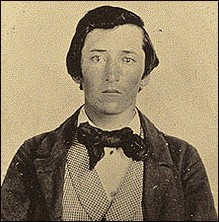
The cellblock on the first floor of the jail building
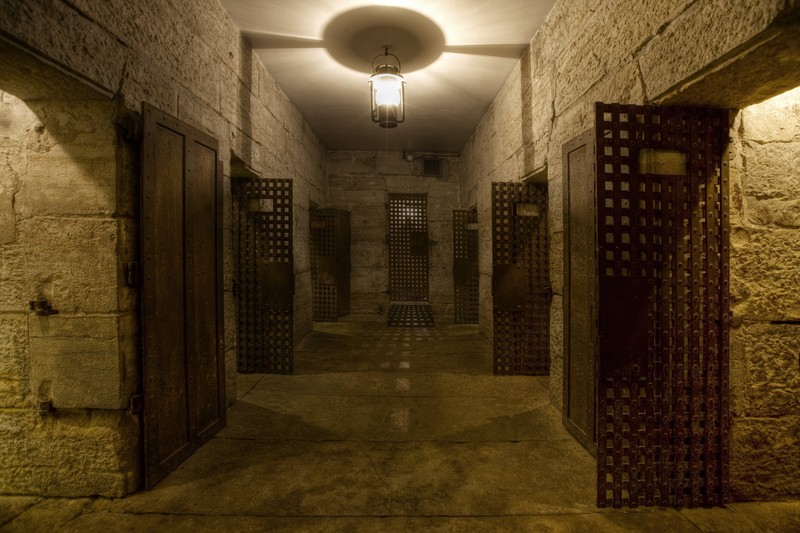
Backstory and Context
Text-to-speech Audio
On the eve of the Civil War, citizens of Jackson and its neighboring counties were deeply fragmented. The preceding Bleeding Kansas conflict, which revolved around Kansas’ entry to the Union as either a slave or free state, was marked by violent, unforgiving guerrilla warfare, pitting neighbor against neighbor. As of 1859, many Independence residents owned enslaved people, and the encroachment of free-state Kansas jayhawkers across the border worried them. Because of mounting fears of violence from guerrillas on both sides of the border, Jackson County Sheriff John Burrus signed off on the construction of a new, high-security prison on the Independence Square. The 1859 jail was both larger and sturdier than the previous Jackson County jail, which had been standing since 1841. Over the next several years, the new jail was central to life in Civil War-era Jackson County, serving a variety of military and political purposes. Perhaps most notably, the jail was used as the office of the Union Provost Marshal for much of the war. The provost marshal system assigned deputy provost marshals to each county in the state whose primary responsibility was preserving order in the area. Among other duties, provost marshals were responsible for investigating and making arrests for disloyal activities, which affected both troops and civilians. A major method of control employed by provost marshals was an oath of allegiance to the Union, which proved difficult for such a divided populace. The fragmented loyalties of Jackson County residents meant that many with Southern sympathies simply lied while taking the oath, while others, some disloyal and some neutral, refused to take it on principle. The provost marshal’s attempts to quell disloyalty in the area meant that the Jackson County Jail held an abundance of military and civilian prisoners during the war, both male and female.
One of the jail’s most famous inmates was the notorious Confederate guerrilla leader, William Quantrill. Quantrill’s stay at the jail was short: he was only imprisoned for one night on December 10, 1860, months before the start of the war. Then only nineteen, Quantrill was jailed following his role in the failed abolitionist raid on a farm belonging to Morgan Walker near Blue Springs. At this time, Quantrill was associated primarily with Missouri border ruffians, many of whom engaged in criminal activity to advocate for their pro-slavery interests. As a young man, Quantrill stole cattle, returned runaway slaves, and turned in notorious jayhawkers, all for a profit. The raid on Morgan Walker’s farm was one such effort. Quantrill, representing himself as an abolitionist jayhawker, joined several other abolitionists with plans to free Walker’s enslaved people, as well as rob him of his cattle. In the process, Quantrill turned traitor on the abolitionists, tipping off the Walker family about the raid ahead of time and asking that he alone be spared. The raid continued as planned, but the others had no knowledge that Quantrill was leading them to their death. Only Quantrill was spared as promised; the other abolitionists were killed by Walker and his neighbors who awaited the attack.
For Jackson County residents, Quantrill’s role in the raid was uncertain. He had provided a story that the jayhawkers had killed his brother, so his betrayal was a justifiable act of revenge, but this was not universally believed. Jackson County Sheriff Burrus worried that Quantrill was himself a dangerous abolitionist planning to attack local enslavers, and several Independence residents demanded his arrest. Quantrill’s one-night stay at the Jackson County Jail was for “protective security.” Upon his release on the morning of December 11, 1860, he was met with an angry mob on Independence Square, insisting that he was a Kansas jayhawker who needed to be hanged. Fortunately for Quantrill, Andrew Walker was there to plead for his safe passage out of Independence. Andrew was the son of Morgan Walker, and he believed Quantrill to be solely responsible for the safety of his family farm. Although his loyalties were still suspect, Quantrill escaped the potential hanging and left Independence.
Quantrill eventually returned to the Jackson County Jail two years later, having since established his reputation as a fearsome Confederate guerilla. Quantrill and several of his band of guerrillas aided Confederate soldiers in the First Battle of Independence in August of 1862, during which Quantrill and his men took the jail from federal control and liberated several southern-sympathizing prisoners who were being held there. The federal Lieutenant Aaron Thomas, attempting to defend the Jackson County Jail and an adjacent hotel, was killed, along with Independence City Marshal James Knowles. The marshal, ironically, was being held in his own prison for killing a non-resisting southern inmate.
Although the First Battle of Independence ended in a Confederate victory, Confederate soldiers quickly left the area, and the jail remained under federal control. During this time, the county provost marshal, headquartered in the jail, focused on keeping order among citizens with conflicting and changing loyalties. The jail overflowed with prisoners who had either confirmed or suspected southern sympathies. Although many locals either attempted or feigned neutrality during the war, this stance was often interpreted as disloyalty by the Union. At times, the small cells were packed with upwards of twenty people each, women and children among them. Southern-sympathizing women were a threat taken very seriously by federal officials, who recognized that the aid they provided to guerrillas was invaluable to the Confederate cause. The imprisonment of women, innocent or otherwise, disturbed the locals. In a February 1863 letter, Independence resident Susan Staples told a friend:
"Col. Penick’s command is stationed at Independence he deals very strict with Southerners he has a great many female prisoners and says that he is going to banish every lady that has husbands in the Southern Army or with the bushwhackers."
A list of prisoners held in Independence by the Jackson County provost marshal Colonel William Ridgeway Penick in October of that year echoes Staples’ concerns: the list of 27 names includes at least five women, one of whom was accused of being a “rebel spy.” Tensions between civilians and the federals occupying the area reached their peak when General Thomas Ewing issued General Order Number 11, which evicted residents of the Missouri-Kansas border counties–mostly women, children, and the elderly–who could not prove their loyalty to the Union. Colonel Penick’s promise in early 1863 to banish disloyal women was not far from the mark. Completed several years after the incident, George Caleb Bingham’s painting “Martial Law” dramatizes the infamous Order Number 11, which felt to many civilians like a senseless act of violence and hostility–and to many Union officials like the only viable option. Evicting civilians from the border region cut off numerous Confederate guerrillas from a network of southern-sympathizing families who provided them with aid and supplies.
Although the Civil War came to an end in 1865, order was not immediately restored to Jackson County, and residents continued to see the effects of war. Guerrilla violence was not immediately forgotten in the area; in fact, some former Confederate guerrillas continued riding after the end of the war, and many old rivalries were not yet put to rest. Although Missouri was a Union state, many in the border region remained sympathetic to the South and resentful of the Union. In June of 1866, a group of five mounted ex-guerrillas stormed the Jackson County Jail to break out a member of their band, Cass County resident Joab Perry, who had been charged with horse stealing. In the process, the current jailer, Henry Bugler, was killed and his 4-year-old son shot in the arm. Following this incident, outraged Independence residents held a town meeting during which they proposed to disarm all “returned rebels”--those who had been disloyal to the Union--in the city. The following week, conservative newspaper The Missouri Republican described the jailbreak, characterizing the town meeting as being driven by “a spirit of vindictiveness, persecution and a want of common sense.” Despite the disruption, the jail continued operating as usual. After Bugler’s death, his pregnant wife Mary was left to care for their six children and up to ten Jackson County orphans placed in her care by the county court. However, she finished her husband’s term as jailer, making her the only woman to have held the position at the jail.
During this time, the jail was home to prisoners who had refused to take the statewide “Ironclad Test Oath,” which required Missouri citizens to swear that they had never committed acts of disloyalty against the Union. Refusal to take the oath would result in complete disenfranchisement. For civil servants, lawyers, teachers, and ministers, refusal--or inability--to take the oath meant they could no longer legally practice their profession and could face time in jail if they continued to work. One such prisoner at the Jackson County Jail was Reverend Abner Deane, who was required to take the oath to continue preaching legally but refused to do so. Deane had no professed Confederate loyalties but chose imprisonment on principle; he believed no one but God could authorize him to preach. Yet again, George Caleb Bingham brought the issue into the public forum through a painting of Deane sitting alone in his cell reading the Bible. The painting caused a fervor in the local press, resulting in Deane’s release on June 14, 1866, just a day after Henry Bugler was killed. The Ironclad Test Oath was declared unconstitutional a year later in 1867, through the case of Cummings v. State of Missouri, in which St. Louis minister Reverend John Cummings was arrested for preaching without having taken the oath. He argued that the oath and its implications denied him religious freedom and its retroactive nature, penalizing citizens for actions taken years prior, was unconstitutional. Violence, discord, and government intervention like these instances persisted long after the official end of the Civil War.
The jail remained open in the decades after the Civil War, holding a variety of prisoners. One of the jail’s most notable post-war inmates was Frank James, a former Confederate soldier, outlaw, and the older brother to the notorious Jesse James. Frank James was jailed on murder and robbery charges from an 1881 train robbery, having surrendered to the Missouri governor shortly after the 1882 death of his brother, likely protecting himself from the same fate. Starting in late 1882, James’s stay at the jail was just 112 days long, and he was released after he was acquitted of every charge by a jury in Gallatin, Missouri. The jailers treated him unusually well, even leaving his cell door unlocked to let him walk the building. The cell itself was the largest in the jail and furnished comfortably. Visitors to the museum can view a cell furnished to replicate James’ lodgings according to newspaper reports. The cell contains fine art, a table and chairs, and an elaborate Brussels carpet.
In 1933, the Jackson County Jail was officially decommissioned, but the building continued to be used for several years. During the Great Depression, it was used for various Works Progress Administration projects like sewing and canning that provided necessary employment and relief to Jackson County residents. From 1941 to 1949, the former jail served as the American Legion headquarters. After the Legion vacated the space, it remained vacant for almost ten years until 1958, at which point it was slated for destruction. The Jackson County Historical Society quickly intervened, attempting to raise funds for the building’s restoration. Former President Harry S. Truman, who had returned home to Independence after his retirement, was involved in the effort to save the jail, making the first campaign call to secure funding for the project. The jail was officially entered on the National Register of Historic Places in 1970, but its restoration came much earlier. Over $30,000 was donated to preserve the “Old Jail,” as locals called it, and the museum officially opened its doors in 1959, just a year after it was set to be demolished. Since then, the 1859 Jail Museum has served as a window into over 100 years of Jackson County history.
Sources
Jackson, David W. and Paul Kirkman. Lock Down: Outlaws, Lawmen, and Frontier Justice in Jackson County, Missouri. Independence, Missouri: Jackson County Historical Society, 2012.
Leslie, Edward E. The Devil Knows How to Ride: The True Story of William Clarke Quantrill and His Confederate Raiders. New York: Random House, 1996.
Liberty Tribune newspaper 1866-06-22, Liberty Tribune Newspaper Collection, William Jewell College, Liberty, Missouri, https://mdh.contentdm.oclc.org/digital/collection/libertytrib/id/168163/rec/874 (accessed December 8, 2023).
List of prisoners confined and on parole by order of Col. Penick, eel F1589, frame 0253, Missouri's Union Provost Marshal Papers: 1861 - 1866, Missouri State Archives, Jefferson City, Missouri, https://www.sos.mo.gov/archives/provost/provostPDF (accessed November 14, 2023).
National Register of Historic Places, Jackson County Jail and Marshal’s Home, Independence, Jackson County, Missouri, National Register #70000333.
Phillips, Christopher. “‘A Question of Power Not One of Law’: Federal Occupation and the Politics of Loyalty in the Western Border Slave States during the American Civil War,” Bleeding Kansas, Bleeding Missouri: The Long Civil War on the Border, pp. 131-150. Edited by Jonathan Earle and Diane Mutti-Burke. Lawrence: University of Kansas Press, 2013.
Staples, Susan. From Susan Staples to Mary W. Mason, Abner Ford Staples Family Papers, State Historical Society of Missouri, Kansas City, Missouri, https://civilwaronthewesternborder.org/islandora/object/civilwar%3A3469?islandora_paged_content_page=2 (accessed November 14, 2023).
“From St. Louis - The Independence Murder Case.” The Chicago Tribune, June 16, 1866, https://chicagotribune.newspapers.com/article/chicago-tribune/87916787/ (accessed December 8, 2023).
Jackson County Historical Society
Jackson County Historical Society
Jackson County Historical Society
